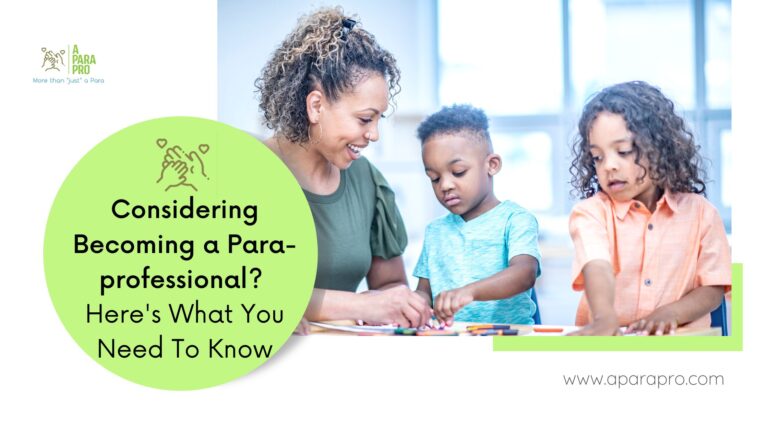A Step-by-Step Guide to Conducting a Paraeducator Self-Assessment
As a paraeducator, you play a vital role in supporting student success and contributing to the overall classroom environment. But how do you ensure you’re continually growing and developing in your role? One of the most effective ways to take charge of your professional development is through self-assessment. Today, we’ll walk you through a step-by-step guide to conducting a self-assessment as a paraeducator, helping you identify your strengths, areas for improvement, and opportunities for growth.

Why Self-Assessment Matters for Paraeducators
Self-assessment is a powerful tool that allows you to reflect on your skills, knowledge, and performance. It’s an opportunity to take an honest look at where you excel and where you might need further development. Regular self-assessment helps you:
- Take control of your professional growth: By understanding your current skills, you can set specific, measurable goals to advance in your career.
- Boost your confidence: Knowing your strengths enables you to approach your work with greater assurance and effectiveness.
- Align with the needs of your students and teachers: Self-assessment helps you identify how your skills meet the needs of those you support, allowing you to make meaningful contributions in the classroom.

Step 1: Gather Your Tools for Self-Assessment
Before you begin your self-assessment, it’s important to gather the right tools. There are several methods you can use to assess your skills and knowledge as a paraeducator:
- Teacher Feedback: Regularly seek feedback from the teachers you work with. This can be informal, like a quick chat after class, or more structured, like a quarterly review. Teachers can offer valuable insights into your strengths and areas where you might improve.
- Reflective Journaling: Take some time at the end of each day or week to reflect on your experiences. What went well? What challenges did you face? Reflective journaling helps you become more aware of your actions and decisions, allowing you to learn from your experiences and improve your practice.
- Observation Reflections: Observe your interactions with students and teachers, as well as the outcomes of your instructional support. Ask yourself questions like: How did I handle a particular situation? Was there a better way to approach it? This process helps you identify patterns in your behavior and areas for growth.
- Self-Assessment Forms: Consider using standardized self-assessment forms designed specifically for paraeducators. These forms typically include statements related to key competencies—like communication skills, instructional support, and behavior management—where you rate your own proficiency.
SHOP OUR JOURNALS
Step 2: Conduct Your Self-Assessment
Once you have your tools, it’s time to conduct your self-assessment. Here’s how to do it:
- Collect Feedback: Start by gathering feedback from the teachers you work with. Ask them specific questions about your performance in areas like classroom management, instructional support, and collaboration. Take notes on their responses.
- Reflect on Your Practice: Use your reflective journal to review your experiences over the past few weeks or months. Look for patterns in your reflections—are there certain challenges you face regularly? Are there areas where you consistently excel?
- Observe Your Interactions: Spend time observing how you interact with students and teachers. Take note of how your actions impact student engagement and learning. Reflect on these observations to identify areas for improvement.
- Complete a Self-Assessment Form: Use a self-assessment form to rate your proficiency in key areas. Be honest with yourself—this is an opportunity to identify areas where you can grow.
Step 3: Interpret Your Results and Create a Development Plan
After you’ve completed your self-assessment, it’s time to interpret the results and create a plan for your professional development:

- Identify Strengths and Areas for Improvement: Review the feedback you received, your reflections, and your self-assessment form. Identify patterns—what are your strengths? Where do you need further development?
- Set SMART Goals: Based on your self-assessment, set Specific, Measurable, Achievable, Relevant, and Time-bound (SMART) goals for your professional growth. For example, if you want to improve your skills in behavior management, your goal might be to complete a specific workshop within the next three months.
- Create a Development Plan: Outline the steps you’ll take to achieve your goals. This might include attending professional development workshops, seeking mentorship from experienced paraeducators, or dedicating time to self-study.
- Monitor Your Progress: Self-assessment is an ongoing process. Regularly review your goals and update your development plan as needed. Celebrate your progress along the way, and adjust your plan to address new challenges and opportunities.
Step 4: Stay Motivated and Keep Growing
Self-assessment is not a one-time event—it’s a continuous process that should be integrated into your regular practice. To stay motivated:
- Set small, achievable goals: Break down larger goals into smaller, manageable tasks. This will help you maintain momentum and see progress more quickly.
- Celebrate your successes: Recognize and celebrate your achievements, no matter how small. This will help you stay positive and motivated.
- Seek support from peers and mentors: Connect with other paraeducators who are also focused on professional growth. Share your experiences, challenges, and successes with them, and offer support in return.

Conclusion
Conducting a self-assessment as a paraeducator is a crucial step in your professional development journey. By regularly assessing your skills and setting clear goals, you can take control of your growth, become more effective in your role, and make a meaningful impact on the students and teachers you support.

Ready to start your self-assessment journey? Download our Para Professional Development Checklist to guide you through the next steps in your professional development and thrive as a paraeducator!
PIN FOR LATER











